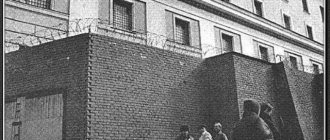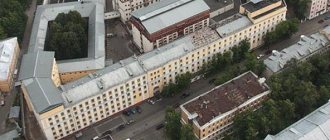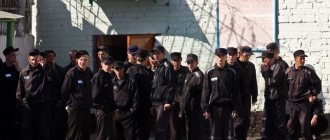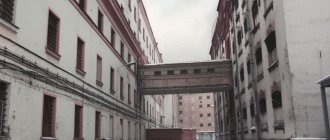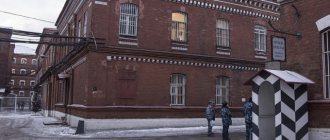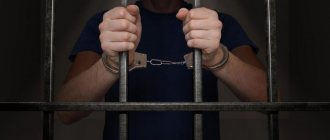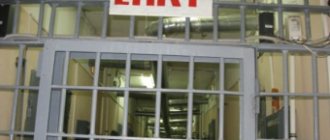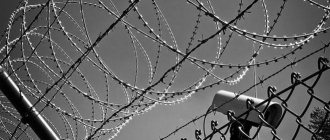Matrosskaya Tishina Street is located in the eastern district of Moscow (Sokolniki district).
Nearest metro station: Sokolniki.
Name
Peter I built a sailing factory on the right bank of the Yauza and settled a sailors' settlement near it. In 1771, the factory was moved to Novgorod, and the factory buildings housed the Catherine Sailors' Almshouse for veteran sailors. According to the emperor's decree, carriages and carts could not travel along this street. This is how the name of the street came about: Sailors' - because the veterans and disabled people were mostly sailors; Silence - because the street was quiet, since no carriages or carts drove along it.
The building of the Catherine Sailors' Almshouse has been preserved and is located in front of the Sailors' Bridge. Now it houses MGUPI (Moscow State University of Instrument Engineering and Informatics - Stromynka St., 20).
Notable
| House 7 - Church of the Annunciation of the Blessed Virgin Mary in Sokolniki (the so-called temple of the Airborne Forces). The church building was built in 1906 at the former barracks of the sapper battalion. In 2004, Alexy II established, at the request of the Airborne Forces commander, Colonel-General Kolmakov, the Patriarchal Compound at the headquarters of the airborne troops in Sokolniki. It includes, among other things, the Church of the Annunciation of the Blessed Virgin Mary in Sokolniki. The temple fence is decorated with military symbols. |
Story
Contrary to popular belief, the Sailor's Silence prison is not called that because it was intended exclusively for sailors. In fact, even under Peter the Great, a settlement for elderly sailors who had retired was located in this area. Subsequently, in 1771, an almshouse was founded there. A special decree prohibited all types of transport from traveling along this street. Thanks to the predominant contingent and the silence reigning there, it received such a name.
The first prison-type institution appeared on Matrosskaya Tishina Street in 1775 under Catherine II. According to the decree of the empress, the most daring and notorious criminals were placed there. Later, in 1850, the Church of the Icon “Joy of All Who Sorrow” was founded at the prison.
In 1870, the prison began to bear the name of the Moscow Correctional Prison. The building was designed to accommodate 150 women and 300 men. Gradually the territory grew, the number of residents also grew, and the need arose for a new building, which was erected in 1912 according to the design of the architect B.A. Alberti.
During the revolutionary years, the prison initially fell into disrepair, but already in 1918 they decided to reorganize it. On the basis of an already existing institution, a correctional institution was founded, where “criminal elements” (mostly young, aged 17 to 21) were reforged and re-educated, learning to work honestly for the good of the Soviet homeland. But, not having lived even a year, the so-called “Reformatorium” went into oblivion. On its basis, the Kozhevnicheskaya children's correctional colony was created.
Sailor's silence under the USSR
In 1945, the correctional facility for children became quite an “adult” facility. In 1947, new buildings were completed, and Matrosskaya Tishina could accommodate more than 2,000 prisoners. At the same time, barracks for the prison employees themselves, a boiler room, and an administrative building were erected on the territory.
In 1949, another building appeared - specifically for the detention of Nazi criminals, as well as scientists who suffered from the second round of Stalinist repressions. Scientists worked here in the so-called “sharashkas”. Subsequently (in 1953), the third building was converted to house juvenile delinquents - here they were engaged in socially useful work (making Christmas tree decorations, envelopes, etc.). For their work, they were given money with which they could purchase goods in the prison shop. The children's prison closed only in 1997. Since 1999, the third building began to be used as a department of the in-prison hospital.
In 1985, the prison was converted into a pre-trial detention center.
Why is it called that?
In 1771, Peter was the first to create a sailors' settlement on the banks of the Yauza River. Its main population was old sailors who repeatedly took part in naval battles. For health reasons, most of them needed rest.
A special decree was issued prohibiting movement on all types of transport of that time. Thanks to this restriction, the street became quiet.
People called it Sailor's Silence. This name has been retained to this day . Due to the location of the prison, its name arose.
Famous prison escapes
Mostly bandits, thieves in law, etc. sat in Matrosskaya Tishina. (for example, everyone knows Volodya Sharapov’s phrase from the film “The meeting place cannot be changed”: “And then they will take him to Matrosskaya Tishina prison - and the khan, you won’t escape from there.”
In reality, escaping from the legendary “Sailor” is quite possible. Probably the most famous - and at the same time successful - escape from here was made by the killer Alexander Solonik. A former special forces soldier who killed such famous authorities as Valery Dlukach, Vladislav Vanner and Nikolai Prichinich. Solonik was called “killer No. 1.”
Alexander Solonik
Alexander managed to bribe the guard, and he brought him special climbing equipment and a pistol. A mannequin was left in the cell to create the appearance of the prisoner's presence. And the fugitives themselves (the warden Sergei Menshikov fled with Solonik) climbed onto the roof through the ventilation system and went down using a rope. However, their fate was sad: Menshikov was killed in the same year, 1995, Solonik - in 1997.
At the same time, we’ll tell you about other successful escapes. True, these prisoners were less fortunate - they were captured within a few days.
In 2004, Sergei Ershov, a citizen of Ukraine, escaped from Matrosskaya Tishina. He managed to dismantle the brickwork and overcome the high fence. Of course, the fugitive received serious injuries and was detained again a day later.
In 2013, Oleg Topalov, who was in jail on charges of theft and double murder, managed to escape from Matroska using the same method as Solonik escaped in the 1990s. Topalov bribed the guard, who brought him a climbing kit, the prisoner climbed onto the roof and easily went down to the street. However, a search for the fugitive was announced immediately, and exactly 24 hours later Oleg Topalov was detained. Interestingly, he was later acquitted of theft and murder, but had to serve a sentence for his escape.
Oleg Topalov
What kind of criminals end up here?
Matrosskaya Tishina is a detention center for ordinary and special prisoners .
Criminals who have committed serious crimes and other illegal acts serve their sentences here.
Those sentenced to a fixed or life sentence can go to this prison. In the pre-trial detention center, detainees, persons under investigation and those under trial are awaiting the court decision and the outcome of the investigation. In the future, these categories of citizens may be transferred to other prisons .
Is it true that the Black Dolphin prison is located in Sol-Iletsk? Find out the answer right now.
Modernity
The cells in Matrosskaya Tishina are designed to hold 3-4 prisoners. Each cell has a refrigerator and a TV. However, according to the latest data, there is obvious overcrowding in the prison, and sometimes inmates even have to take turns sleeping.
There are regular reports in the media about periodic violations of the rights of prisoners in this prison. The latest such high-profile case is the murder of the defendant Alexei Shangin in 2015. A 35-year-old man was brutally tortured; the torture lasted more than a day. The Muscovite died from painful shock; his body was found to have a traumatic brain injury, combined injuries, burns to the head, legs and arms. Due to unacceptable treatment of a prisoner, the head of the operational department, Mikhail Zakharov, was fired. According to investigators, the murder was committed by Alexei's cellmates. But perhaps they were simply following orders from someone from the prison authorities? One way or another, there is no complete clarity in this matter yet. And information about the use of unacceptable measures of influence in “Matroska” is leaked to the media with enviable regularity.
Alexey Shangin
Matrosskaya Tishina Pre-trial Detention Center 1 now
Today, the Matrosskaya Tishina prison is conditionally open to representatives of the media and various public organizations. From time to time, excursions of sorts are held there to show the life and living conditions of prisoners.
Naturally, during such events, visitors are shown the best cameras, recreation areas, and so on. In contrast to this, periodically there are reports in the media about violations of the rights of prisoners, non-compliance with detention standards, hunger strikes, riots, escape attempts, deaths and other unpleasant moments, which allow us to judge that not everything is so smooth in pre-trial detention center No. 1.
Moreover, such disadvantages are observed not only in terms of the maintenance of prisoners. So, about a year ago, information appeared that a reduction in the staff of the Federal Penitentiary Service led to their significant reduction. This gave rise to concerns on the part of the guards of pre-trial detention center No. 1. As employees of the penitentiary service admitted, due to the reduction in the number of guards, it became simply dangerous to work.
Daily routine in prison
Prisoners wake up at 6:00 a.m. and go to bed at 10:00 p.m. Sleeping or lying on beds during the daytime is strictly prohibited. Prisoners are notified of the need to wake up or go to bed by an audio signal. The light in the cells never goes out; at night it is simply switched to a less powerful mode.
The menu for breakfast, lunch and dinner is practically no different; each meal consists of standard three courses.
You are allowed to wash once a week - in a bathhouse or shower, and you need to do it for 15 minutes.
Walks are held daily and take an average of one hour. The cameras are visited every day from 8 to 9 am.
Daily routine in prison
Reception schedule for citizens
Citizens can get an appointment from 14:00 to 16:00 daily.
Statements from relatives
Relatives can apply for a visit. A sample application can be found on the official website.
Transfers
The parcel can be given to the convicted person on Sunday from 9:30 to 14:00.
Each convicted person in prison has the right to receive no more than 6 parcels per year, that is, a parcel can be delivered once every 2 months.
You can transfer no more than 20 kg of items. Convicts who are in lighter conditions have the right to count on monthly transfers.
You should not transfer items that are prohibited for use in the pre-trial detention center. By handing over such items, you provoke the prisoner to commit violations, which, in turn, will result in disciplinary action.
In addition, you can support the prisoner by sending a parcel. Each prisoner has the right to receive parcels whose weight does not exceed 30 kg per month, the weight of all parcels is summed up.
Dating
According to the law, persons held in pre-trial detention centers are entitled to no more than two visits per calendar month. Visits may include both relatives and other persons. No more than 2 people are allowed on dates.
For each such meeting, it is necessary to draw up documents indicating who can meet with whom. Documents can be processed from Monday to Thursday from 9630 to 16:00, on Friday from 9:30 to 15:00, on Saturday and Sunday from 9:30 to 14:00.
The last Monday of every month is a sanitary day.
Persons who have not provided identification documents, as well as those who arrive under the influence of alcohol or drugs, are not allowed to visit.
Employees have the right to terminate a visit in case of violation of the rules in force on the territory of the pre-trial detention center. Dating takes place on a first-come, first-served basis.
A long date is allowed once every 3 months. If the prisoner is kept in light conditions, a long visit can take place once every 2 months. There is a fee for using the room for long meetings.
It starts at 9 am. The police will allow no more than 2 people, which includes minor children. If a person who has arrived for a long date leaves the room intended for him, then the date is considered to be over. You won't be able to get there a second time.
A convicted person has the right to receive meetings with a lawyer for a duration of 4 hours without restrictions.
Individual appointment
Citizens can get an appointment individually on Tuesday, Wednesday and Thursday from 9:30 to 16:30.
On Tuesday the reception is conducted by the Deputy Chief for General Affairs Oleg Midekhatovich Gafarov, on Wednesday you can get an appointment with the Deputy Chief for Security and Regime Sergei Pavlovich Kozlov, on Wednesday the reception is hosted by the Acting Chief Anton Stanislavovich Podrez.
The case of VIP cameras
In 2022, a scandal broke out and several people were removed from leadership positions. The thing is that so-called “VIP cells” were discovered in the prison, equipped with greater amenities than the others. They were completely renovated, had a plasma TV, a refrigerator, high-quality furniture, showers, a separate toilet, etc. Only fairly wealthy inmates could enjoy such conditions - mostly thieves or dangerous swindlers.
VIP chamber interior
In VIP cells it was allowed to use mobile phones; if desired, a person could sit in such a cell alone or with other people (who were also asked for their consent). As a justification, the prison authorities cited the argument that the proceeds from such cells go to improve the living conditions of other prisoners.
When news of the VIP conditions leaked to the media, representatives of the Federal Penitentiary Service wrote in every possible way that in fact there were no special cells - some were simply lucky with the repairs, and others were not. However, former prisoners claim that for a bribe you can use, for example, a mobile phone even in a regular cell. Also, some concessions are granted to patients - they may sometimes be allowed to order food separately, including from catering establishments (restaurants, cafes).
Is there an official website?
Sailor's Silence has two official websites https://www.sizo-matrosska.rf and https://www.sizo-1.ru/.
Detailed information about the isolation ward is available on the website https://www.77.fsin.su. Additional information about the history of the prison, significant events associated with its prisoners and other data can be found on numerous websites dedicated to the crime topic.
The official resource contains complete information about Matrosskaya Tishina, including the schedule for receiving citizens, features of the detention of prisoners, management contacts, etc.
Conditions of detention
There are currently many more prisoners in Matrosskaya Tishina than expected. The limit is 800 people. In this regard, prisoners often receive complaints about accommodation . So, for example, in one cell of the first building, where there are 10 beds, there are 18 prisoners, although the cell is generally designed for 6 beds. The prisoners independently constructed sleeping places for themselves from ropes (https://www.mk.ru/social/2017/12/13/ad-v-matrosskoy-tishine-sosedstvuet-s-pyatizvezdochnym-raem-dlya-bogatykh.html).
In addition to overcrowding, there are many other obvious problems. Bed linen is changed very rarely, and cleaning is also done infrequently. You can guess that with such a large number of people in one cell there is much more dirt.
Unlike other Russian pre-trial detention centers, there are no refrigerators in the cells of Matrosskaya Tishina . Due to this, prisoners have to breathe in the putrid smell of food in their cells.
But not every building has such a routine. In the second wing of the building, the cells are filled with 3-4 people. Unlike the previous building, renovation work is underway here, and the building looks very clean inside. Cleaning is done quite often. The cells have a refrigerator, TV, table, washbasin and even a shower room with a toilet, and shelves for personal belongings.
And there are cameras that are more like cozy rooms in a house . They have been beautifully renovated, have an excellent toilet and bathroom, many different shelves for kitchen items, a refrigerator, a wardrobe, two large windows, and a TV. After reading this, it’s hard to believe that we are talking about a place of deprivation of liberty, but this is really so. In one of these cells was the swindler Dionisy Zolotov.
The reason for the uneven distribution lies in the status of each suspect. In the first building there are foreigners, courtesans, petty thieves and others. In the second - businessmen, deputies and other people caught in any crimes.
In Matrosskaya Tishina, prisoners can wear any clothes that are comfortable for them. Despite the fact that there is a hospital on the territory of the pre-trial detention center, patients are not examined so often due to their number. Doctors simply do not have time to see everyone at once. For this reason, many prisoners get very sick. There is a constant epidemic of lice in the pre-trial detention center .
Schedule
The daily routine of the sailor's silence is not much different from other pre-trial detention centers. Let's look at it in the table:
| Climb | 6:00 |
| Morning toilet and cleaning of beds | 6:00-6:30 |
| Cleaning the cells | 6:30-7:00 |
| Breakfast | 7:00-8:00 |
| Morning check, medical examination | 8:00-9:30 |
| Personal time | 9:30-12:00 |
| Walk | 12:00-13:00 |
| Dinner | 13:00-14:00 |
| Walk and personal time | 14:00-17:00 |
| Dinner | 17:00-18:00 |
| Cleaning the cells | 18:00-19:00 |
| Personal time, watching TV | 19:00-20:00 |
| Evening check | 20:00-21:30 |
| Preparation for sleep | 21:30-22:00 |
| Dream | 22:00 |
Nutrition
In Matrosskaya Tishina, food is brought to prisoners in their cells . There are three meals a day: breakfast, lunch and dinner. The prisoners are fed very well. Back in 2013, Vladimir Zhirinovsky came to this pre-trial detention center to familiarize himself with the conditions of detention. According to him, the food is fully consistent with the life of the country, perhaps even better.
- For breakfast, convicts are fed porridge: oatmeal, rice or millet. They give a piece of white bread with butter, tea or cocoa, sometimes yogurt or cottage cheese.
- For lunch , as expected, the first course can be cabbage soup, borscht, rassolnik, solyanka and pea soup. And the second course is meat or fish with any type of side dish (buckwheat, rice, mashed potatoes). Compote or juice with a piece of bread.
- Dinner can consist of dumplings, buckwheat with fish, cutlet, etc.
Just like in any other MLS, it is possible to have your own food. Relatives can bring it, or you can order it from a local stall.
Work and study
In pre-trial detention centers, including Matrosskaya Tishina, prisoners cannot work and study remotely . They can only learn any science on their own, using books and TV.
Religious issues
In 2022, a church was built on the territory of the pre-trial detention center, where the senior priest, Archpriest Sergius Kiselev, constantly comes. He often meets with prisoners, teaches them how to pray correctly and is a spiritual mentor. In Matrosskaya Tishina there are a lot of believers who have crosses, icons, the Bible and other religious objects that are not prohibited in the MLS. On weekends, a service is held in the temple, which prisoners can attend.
Entertainment and relaxation
There are televisions in the prisoners' cells, which they can watch in their free personal time. The television program is selected by the management of the pre-trial detention center itself . There is also a library with a large selection of books.
In one of the buildings there is a club where various kinds of events are held for prisoners. Holidays are celebrated here, prisoners themselves can perform on stage and show their creative abilities. In the cell, prisoners constantly play cards until the guards see it.
Every day, prisoners are taken for a walk on the roof in special cells where there is a view of the sky (instead of a ceiling there is a grill). Here they can breathe fresh air and chat with each other.
Dates and visits
Visits with relatives are allowed in sailor silence . There are no specific restrictions on the number of visits. From Monday to Sunday, the time for short-term visits is from 9:30 to 17:30.
Transfer of products and things
The transfer of food, belongings and medicines is carried out daily from 9:30-16:30. The list of prohibited and permitted products can be viewed on the official website listed above.
So, for example, it is allowed to bring :
- bread;
- salo;
- cheeses;
- oil;
- cold smoked fish, etc.
Forbidden:
- cereals;
- raw meat and fish;
- greenery;
- cucumbers;
- tomatoes, etc.
All permitted products and items will be confiscated by the detention center staff . If you intentionally carry (transfer) a prohibited item to a prisoner, the relative who brought the parcel will be subject to administrative or criminal punishment.
Punishment cell
Like any other place of deprivation of liberty, there is a punishment cell where prisoners are sent for bad behavior and non-compliance with the laws of the prison. Unlike prisons and colonies, the punishment cell in Matrosskaya Tishina is a rather cozy cell, with a bed, a table and a shelf for personal belongings. A prisoner can spend up to 15 days in a punishment cell. But, of course, here, as elsewhere, the guards do not give rest to the violent prisoners of the punishment cell - they constantly “remind themselves.”
Not a holiday home
The management of the detention center strives to improve the conditions of detention of detainees as far as possible. But not all the premises inside the institution have been adequately renovated, although work in this direction is constantly being carried out, gradually changing not only the appearance of the Matrosskaya Tishina pre-trial detention center, but also the decoration of the cells.
The main problem of the pre-trial detention center is terrible overcrowding, due to which in cells with an area of 12 square meters. m are inhabited instead of 3–5 people by a dozen or more offenders. It gets to the point where there simply aren’t enough sleeping places. Because of this, detainees are forced to either sleep in turns or independently make hammocks on the level of the second or third tier of beds. However, the management of the institution is trying to solve this problem.
